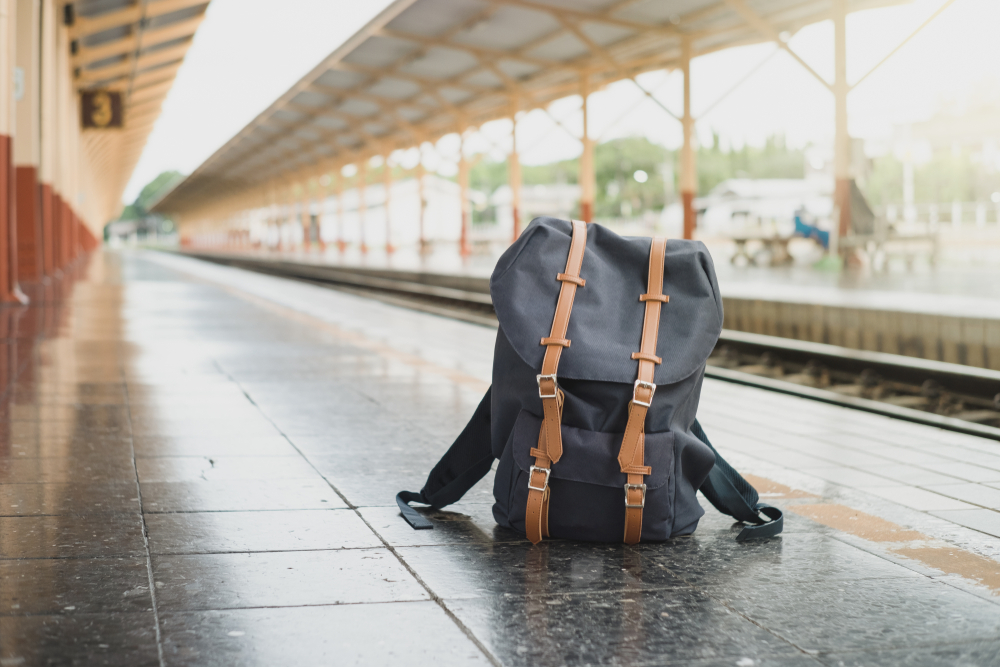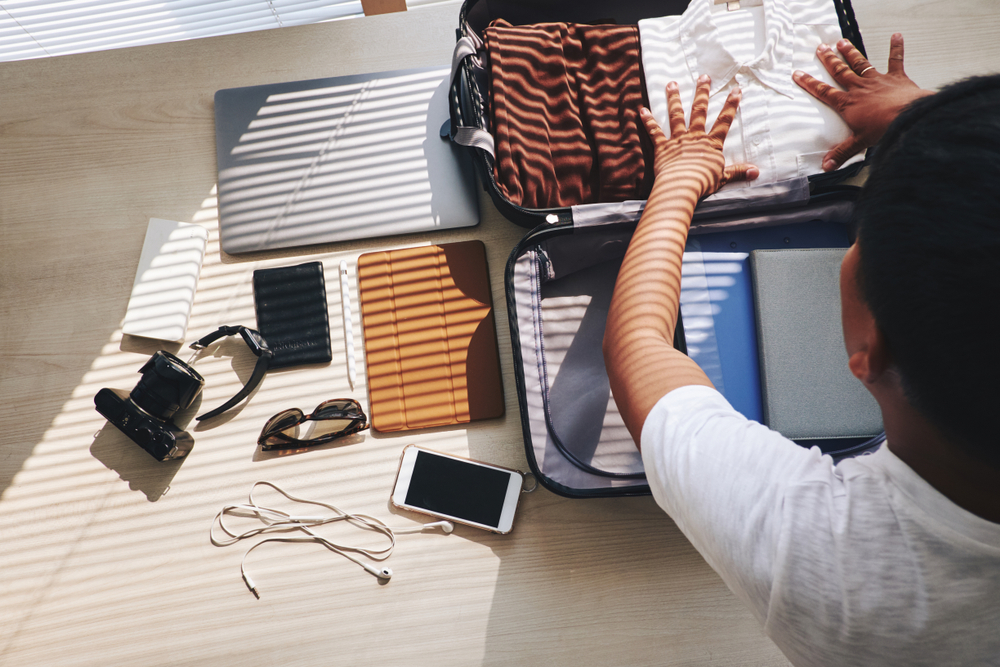Observing feeble attempts to stack airport carts sky high with boulder-like suitcases and precariously perched bags never gets old, especially when someone has to act fast and rescue a piece of luggage that starts to tumble off into the terminal. It’s like Tetris, but a nightmare.
As a self-proclaimed minimalist, all of my earthly possessions can fit into an early 2000’s mini van, and I find myself flabbergasted (and downright terrified) by the amount of baggage people choose to haul across the world.
The nirvana of traveling with less.
Less stuff = greater mobility = more freedom, hands down. The last thing you want to deal with when you’re running to catch your last minute train in Sri Lanka is a rickety suitcase that weighs more than a small child. Not only does traveling lighter make things physically easier, it’s also cheaper, saves time, and teaches you a thing or two about living with less material items (and why it rocks).
From sweating buckets in balmy Vietnam to gliding across icy ponds in Montréal, the four-season pack has got your back. Here’s how to do it.
Step 1: Choose your carry on

Carry on bags come with all sorts of bells and whistles nowadays, anything from portable charger suitcases to ergonomicly-designed backpacks. I will admit, I was at one time wooed by the idea of plugging my phone into my suitcase for a convenient charge, until I said screw that and got a backpack with zero technological capabilities, but a universe of useful compartments and zippers. After all, we could all stand to unplug more often. Here are some considerations when choosing your fine carry on vessel:
Quality: Don’t skimp on it. The last thing you want is a broken zipper or a flimsy arm strap that rips upon pick up. The material, however, should still be lightweight, flexible, and preferably water resistant.
Liters: I’ve lived out of a 46-liter backpack for months on end. You might want a hair more, but I can attest, it’s a rockstar size for fitting four seasons of clothing.
Compartments: Separating your underwear from your chargers is always nice. A laptop sleeve doesn’t hurt either if you’re working on the go.
Comfort: Do yourself a favor and try it on: walk around with it, do some squats, anything to forecast how it’ll feel on top of Mount Kilimanjaro or the bustling city streets of Rio de Janeiro.
Step 2: Evaluate actual needs versus frivolous wants

The semantics of modern day language have diluted what it means to need something. We find ourselves saying things like, “I need that 15-foot inflatable flamingo,” when in reality, needs cater to what we need to survive and function in society (lookin’ at you, pants). The distinction is pretty simple and will help you whittle down your luggage into a well-oiled machine instead of a clunky clusterf*ck.
Every time I pack an item, I consider my destination and the amount of joy and utility the item will provide. Ask yourself, how will this serve me? Is it a duplicate or unique in comparison to what I’ve already packed? Once I get to my third or fourth pair of shorts, it’s time to reevaluate and cut back.
Follow the three-piece rule: Don’t take more than three pieces of one type of clothing. I never let myself bring more than three pairs of shorts. No more than three t-shirts. It doesn’t have to be completely rigid; if you skip out on other items completely, there’s some wiggle room for a few more tank tops or whatever strikes your fancy the most.
Step 3: Make function = fashionable

Making function fashionable is the next step to cutting down your crap even more. While I generally wear whatever is easiest, I do enjoy coordinating the (few) clothes I own to have outfits for when I’m not on cramped busses or sleeping on planes. The golden method is figuring out a color scheme that works for you, and to bring basic pieces that can be worn in a myriad of different ways.
The upside of packing for four seasons is that you really only have to consider the extremes: winter and summer. Spring and fall are mild enough that they can fall between the cracks and it’ll all work out clothing-wise. If I’m packing for four seasons, here’s a general list of what I’ll bring:
Year round:
· 7ish pairs of socks (win some, lose some in transit)
· 7-10 pairs of underwear
· 1-2 t-shirts
· Toiletry bag
· Athletic shoes
· One pair of “nice” shoes, probably suede boots.
· A pair of cozy shorts for sleep, trains, and planes
Winter specifics:
· One pair of jeans
· One pair of leggings
· One lightweight scarf
· 1 long sleeved shirt or turtleneck
· 1 lightweight sweater
· A lightweight jacket, usually leather.
Summer specifics:
· One pair of denim shorts
· One denim skirt (same one every time)
· One black sundress
· Three tank tops
· One swimsuit
· One pair of flip flops or sandals
The list will differ depending on your identity and style preferences, but the volume is on point for a four season carry on. I’m partial to dark clothing, meaning that 85% of the above items are black, making them less susceptible to stains and far easier to mix and match without revealing the heinous amount of repetition in my wardrobe.
Step 4: Put the puzzle together (and keep it fresh)

There’s a lot of buzz about the best way to pack your clothes. Between endless packing cubes and Marie Kondo-level underwear rolling, it’s hard to decipher what’s going to maximize your space. Personally, packing cubes seem like an unnecessary additional purchase, and I’d rather govern my own underwear than take someone else’s advice. Packing, however, can be made more efficient by doing the following:
Put heavier items on the bottom: shoes, bulky clothing, and things you use less often.
Use separate compartments for underwear and socks: It makes it far easier to grab what you need, when you need it.
Keep a laundry bag: Unless you want your fresh shirts to smell like old socks, this one is highly advisable (if you’re going to ignore everything else, at least listen to this). It can just be a grocery store bag; mine usually are.
Don’t forget: bringing a hat is a downright commitment

After buying my first Panama-style hat from a man on the street in Cartagena, the hat-less life was history to me. Unbeknownst to me at that point in time, traveling with a hat is one feverish commitment. For one thing, it’s about as packable as a delicate vase and quite susceptible to the permanent crunch of compression that a quick bag stash can bring. You have to fight for that hat — whether by running down the train platform after the wind knocks it down, sweating through the brim in Amazonian humidity, or mumbling a half-asleep apology when it falls onto your neighbor’s lap during a flight (to name a few). On the very shiny bright side, people seem to dig hats to an astronomical extent, and it starts a lot of conversations when I’m traveling alone.
Is it worth it, you may ask? In my humble hat-wearing opinion, you’re damn right it is. It’s an undeniably groovy way to look (and feel) like a badass Indiana Jones vagabond, but it’s not for the faint hearted. For the love of God, please just stay away from fedoras.